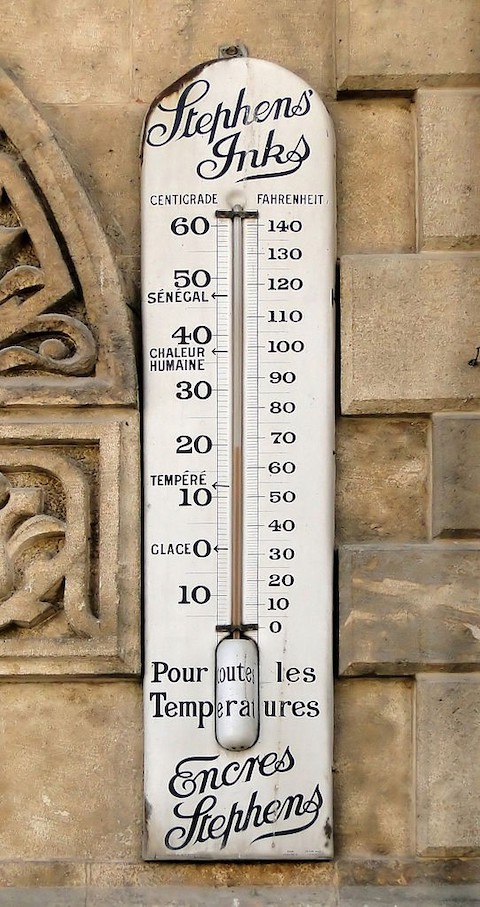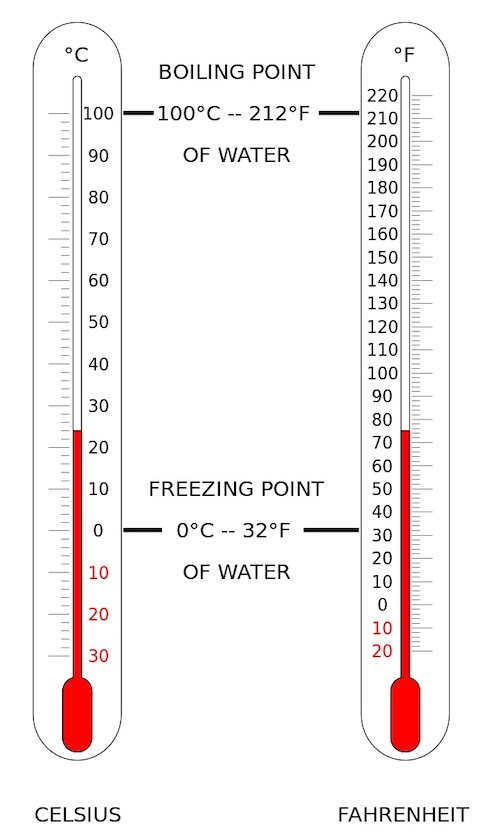
Credit: Bernard Gagnon, via Wikimedia Commons
Here’s a trivia question for you: How many countries today measure temperature in Fahrenheit?
We’ll get to the answer through a story.
By the 1600s, scientists had invented early thermometers. Using air, then alcohol, then mercury—all things that expand with rising temperature—they could tell you … if it was hotter or colder.
But they couldn’t tell you by how much, because no one had standardized a way to measure it.
Around 1700, German scientist Daniel Fahrenheit came up with a scale. He found the coldest temperature he could achieve in his lab using a mixture of ice, water and salt and called that zero. Then used the approximate temperature of the human body as 100.
This made the freezing and boiling points of water at sea level the rather random numbers of 32 and 212. But he put his scale on his new glass thermometer. And because it was the most accurate instrument to date, it stuck.
In the 1770s, British scientists adopted it, then standardized it across the entire British Empire.
Meanwhile, the rest of Europe adopted a simpler scale devised by Swedish astronomer Anders Celsius. Also called centigrade, it used the freezing point of water as zero and boiling as 100.
In the 1960s, the Brits, too, switched to Celsius, leaving the U.S. and just five former British colonies—all of them small island nations—stuck on Fahrenheit.
Background
Synopsis: For most people in the world, a weather forecast of 25 degrees would invoke visions of an outdoor picnic, but it would send Americans running for a winter parka. Americans and just five other small countries use a temperature system called Fahrenheit, while the rest of the world uses the Celsius system. Both systems were invented in the 1700s and both are still in use centuries later. Lacking a thermometer? Crickets can tell you the temperature—in degrees Fahrenheit or degrees Celsius.
- Thermometer comes from the Greek for “hot,” thermos, and “measure,” metron.
- Thermometers use materials that expand when heated and contract when cooled, like alcohol or mercury, to measure absolute temperature.
- Temperature is a numerical comparison of the level of hot or cold and is calibrated to the freezing and boiling points of water using two different scales: Fahrenheit and Celsius.
- Weather thermometers have a large range that covers typical atmospheric temperatures, while medical thermometers require more precision but only need to cover the range of temperatures typical for the human body. Scientific thermometers are specialized to cover much larger temperature ranges.
- As early as 400 BCE, Hippocrates noted that the human hand could be used to estimate the presence and severity of fever and disease, but the earliest thermal instruments were not developed until the late 16th century.
- In 1593, several inventors, including Galileo, invented the thermoscope, a device that measured relative temperature using the change in the volume of air at the sealed end of a tube with its open end submerged in water. Without a scale, these instruments could only show that something was getting hotter or colder.
- In 1610, Galileo created the alcohol thermoscope by using wine instead of water. Pure alcohol enables measurement of temperatures below the freezing point of water down to -170°F (-112°C).
- In 1612, Santorio Santorio, an Italian inventor, added a numerical scale to the thermoscope with a glass bulb that was designed to be placed in a patient’s mouth. This was the precursor to the modern clinical thermometer, but it was large and unwieldy and produced unreliable results.
- In 1654, the first sealed thermometer was invented by Ferdinand II de’ Medici, Grand Duke of Tuscany, using alcohol. It separated the alcohol from the effects of barometric pressure but was still pretty imprecise.
- Those using thermoscopes and thermometers in the mid-1650s understood clearly that the development of a standardized temperature scale was necessary so temperatures could be measured and compared among multiple devices.
- In 1665, Christiaan Huygens suggested building a temperature scale pinned at the freezing and boiling points of water, the phase changes of H2O.
- In 1701, Sir Isaac Newton suggested breaking the scale into 12 units between the freezing point of pure water and the average temperature of the human body.
- In 1709, a German physicist and instrument maker named Daniel Gabriel Fahrenheit (1686–1736) invented a more accurate alcohol thermometer.
- Then, he used his glassmaking skills to invent the first mercury thermometer in 1714, using mercury’s higher coefficient of expansion to improve the precision of the readings for medical use. Mercury freezes at -37.9°F (-38.8°C).
- In perfecting these thermometers for medical customers, Fahrenheit realized that he needed to create a standard scale to be inscribed on each instrument to demonstrate the reproducibility of measurements from device to device.
- After working on the challenge for about a decade, in 1724 he introduced the Fahrenheit scale.
- He set 0°F at the temperature of an equal mixture of water, ice and salt, and 100°F near the average temperature of the human body (now known to be 98.6°F).
- Using this basis, the freezing point of pure water landed at 32°F, and the boiling point of pure water at sea level was 180 units, or degrees, higher, at 212°F.

Credit: Gringer, via Wikimedia Commons
- In 1742, Swedish astronomer Anders Celsius (1701–1744) invented the centigrade system, with 100 divisions between the freezing and boiling points of pure water.
- As a physical scientist, he was more focused on atmospheric measurements.
- He developed careful experiments to confirm the following:
- The freezing point of pure water does not change with latitude or elevation
- The boiling point of pure water does change with elevation because of its dependence on atmospheric pressure.
- In nature, subfreezing temperatures are more common than those above boiling, so to avoid expressing colder temperatures as negatives, Celsius designated 100° for freezing and 0° for boiling. After his death, the scale was flipped to the current configuration with 0° for freezing and 100° for boiling temperatures.
- Within just 18 years, scientists had two standardized temperature scales to consider. The more finely graded Fahrenheit scale provides higher precision for medical uses, while the more symmetric Celsius scale offers higher flexibility for scientific uses.
- The British Royal Society adopted the Fahrenheit system in 1776, and its use spread to all the British colonies, including Australia and the former colonies of the United States.
- During the French Revolution from 1789 to 1799, French scientists took the opportunity to simplify the numerous systems of measurement that had sprung up in Europe by developing the metric system. The base-10 centigrade temperature system of Celsius neatly fit into the overall base-10 schema of the metric revolution.
- In 1948, the metric centigrade temperature scale was formally named the “Celsius” scale by an international conference on weights and measures.
- In 1848, a Scottish physicist named William Thompson, First Baron of Kelvin, modified the Celsius scale to enable the scientific measurement of extreme heat and cold.
- He had developed the idea of absolute zero, the temperature at which all molecular motion stops. Everything freezes at absolute zero.
- Absolute zero occurs at a temperature of -275.15°C (-459.67°F).
- The Kelvin scale uses the same-sized increments as the Celsius scale but shifts the zero point to absolute zero.
- Water freezes at +275.15 K and boils at +375.15 K.
- Because nothing can be colder than absolute zero, no negative numbers exist on the Kelvin scale. This finally addressed Celsius’s concern about dealing with negative cold temperatures!
- English-speaking countries kept using Fahrenheit until the 1960s, when the United Kingdom switched to the metric system to align with the rest of Europe.
- In 1975, the United States Congress passed its Metric Conversion Act, but because it made conversion voluntary, most American businesses didn’t adopt the worldwide-standard system.
- Today, the United States, the Bahamas, the Cayman Islands, Palau, the Federated States of Micronesia and the Marshall Islands are the only countries that exclusively use Fahrenheit temperatures. Some other nations use both systems, including Belize, the British Virgin Islands, and Bermuda.
- The United States National Weather Service (NWS) reports temperatures in Fahrenheit for the American public, but NWS scientists use Celsius temperatures in their work and to coordinate with other scientists globally.
- Converting Fahrenheit to Celsius is one of the most complex conversions of the English-to-Metric conversions, but breaking the process into a couple of steps makes it fairly easy to accomplish. A change of 1°C is equivalent to a change of 1.8°F.
- To convert …
… Fahrenheit to Celsius: Subtract 32, then multiply by 5, then divide by 9.
… Celsius to Fahrenheit: Multiply by 1.8, then add 32.
… Celsius to kelvin: Add 273.15 to Celsius.
- To convert …
- The Old Farmer’s Almanac provides yet another way to measure air temperature—by counting the chirps of crickets!
- In 1897, Amos Dolbear published an article that correlated ambient air temperature with the chirping rate of crickets.
- In order to chirp, crickets must rub their wings against each other, and they must use their muscles to move their wings.
- As cold-blooded creatures, when it is warmer, their muscles activate more easily, and they chirp rapidly. When it is colder, they chirp slowly.
- Dolbear’s Law makes it possible to calculate the temperature from these chirps:
- For Fahrenheit, count the chirps in 14 seconds and add 40.
- For Celsius, count the chirps in 25 seconds, divide by 3 and add 4.
- Kelvin doesn’t work out very well for these little critters!

